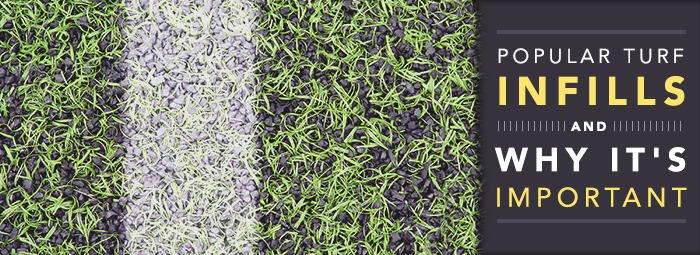
Originally posted on August 12, 2016
Artificial turf turns any area into a perfect outdoor sanctuary, no matter the weather, without worrying about location constraints. It’s akin to a magical carpet, imitating the allure of natural grass, allowing you to tailor the appearance, texture, and durability of the landscape. However, just like real grass grows from soil or sand, synthetic turf requires its essential layer, known as infill, to maintain its upright and robust stance.
Before you install artificial turf it’s important to understand exactly what kind of infill you need, and why.
Turf Infill and Why It’s Important
Turf infill is the substance that gives your artificial grass its realistic cushion, spring, and density. It plays an important role in keeping your field functional, and the following benefits are among the most essential:
- Supporting Grass Fibers: Field turf relies on its infill to support and protect each fiber of “grass.”
- Maintaining Dimensional Stability: Infill keeps turf upright by allowing blades to stand up and stay up.
- Adding Volume: Athletic fields must have sufficient cushion and bounce, and turf infill adds volume to the top layer of turf while providing a substitute for soil, sand, clay, and other natural ground materials that may be sparse on your field.
- Simulating Soil: If your athletes play on real grass but practice on turf or vice versa, it’s very important to simulate the bounce and texture of real grass.
- Cooling: Synthetic turf may attract excess heat without the benefits of UV-resistant infill, such as acrylic-coated sand that prevents the absorption of solar energy.
Popular Types of Turf Infill
Manufacturers have come a long way since the toxic, dirty rubber that once padded artificial fields. Today, popular types of turf infill include the following:
Crumb Rubber Infill
Black crumb rubber is widely used for large athletic fields because it is soft and supportive enough to add significant volume and cushion. Dimensional stability is particularly easy to maintain with crumb rubber, because each granule works together to support each blade of artificial grass. Your turf will stay upright, and any woven strands will maintain their density.
Silica Sand Infill
Many field and facility managers combine silica sand infill with rubber or acrylic-coated sand infill, because this product adds volume while providing cooling benefits. Sand is UV-resistant, so your synthetic field will not absorb as much moisture if silica sand is used in the infill that supports it.
Plant Fibers and Cork
Sometimes, the best alternative to natural materials is another natural material. Some fields are supported by synthetic fibers that came from all-natural, plant-based sources. Plant fibers and cork are especially popular for fields that are exposed to high heat or extra wear and tear, because they are naturally non-toxic and UV-resistant.
Thermoplastic Infill
Thermoplastics are synthetic rubbers that were engineered to resemble natural surfaces. These granules may be brown, black, or green, but they all allow tighter grass weaves to simulate the appearance of a real grass field. The size of each granule may vary according to the type of turf you need to support.
Acrylic-Coated Sand Infill
Sand infill is a popular choice for small athletic fields, pet runs, and children’s play areas. Acrylic coating gives each granule antimicrobial properties, and this infill doesn’t absorb liquids, odors, or stains, which makes it particularly popular for pets and kids. It is cooler to the touch and longer-lasting, but if you want to use acrylic-coated sand for an athletic field, you may need a pad to cushion hard falls. Acrylic-coated sand doesn’t always cover the same volume as rubber either.
Infill Alternatives
Some turf doesn’t need infill. For example, batting cages and other multipurpose indoor facilities may have turf with nylon thatch. SportMax and other multipurpose, indoor turf products are mixed with this artificial thatch to improve durability and simulate the padding of real soil. Meanwhile, Poly Putt and other putting green turfs have urethane backings that are designed for sand-filled surfaces. Actual infill isn’t necessary to cushion these products.
Choosing The Right Turf Infill
Artificial turf is a rare improvement on nature, offering better hygiene, water-resistance, cushioning, color, and consistency than natural grass. However, your infill selection will ultimately determine the overall effect of your turf. Athletes depend on infill to support and protect them, and it must also properly simulate the natural fields on which they play. Browse our selection of sports field turf to learn more about the benefits of artificial athletic fields and the importance of synthetic turf infill.







